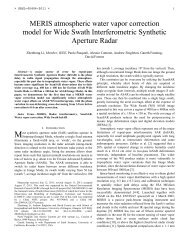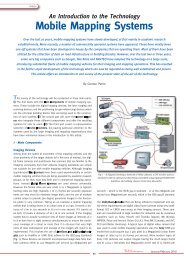Houdini and the wonder of
Houdini and the wonder of
Houdini and the wonder of
You also want an ePaper? Increase the reach of your titles
YUMPU automatically turns print PDFs into web optimized ePapers that Google loves.
2.<br />
A student goes home after attending a university class where she has been told to go<br />
<strong>and</strong> do an ‘experiment’ which will form <strong>the</strong> basis <strong>of</strong> <strong>the</strong> next lesson. Her instructions<br />
are simple: she is to go into a café during a quiet period, buy her c<strong>of</strong>fee, look around<br />
<strong>and</strong> <strong>the</strong>n select a table with someone else or a group already sitting at it with whom<br />
she is unacquainted. Without saying anything she should pull out a chair <strong>and</strong> sit at <strong>the</strong><br />
table. She should not say why she is sitting at <strong>the</strong> table, though she can engage in<br />
conversation on whatever o<strong>the</strong>r topic. Whe<strong>the</strong>r she is engaged in conversation or not<br />
she should drink her c<strong>of</strong>fee in a relaxed <strong>and</strong> friendly manner, as if <strong>the</strong>y were old<br />
acquaintances. She must not give up her seat at <strong>the</strong> table. Only when she is leaving<br />
should she explain that is doing an exercise for a university course on social<br />
interaction in public places.<br />
When <strong>the</strong> class finally get back toge<strong>the</strong>r she relates her story <strong>of</strong> sitting down at a table<br />
with an old woman, who looked fairly harmless. Having sat at <strong>the</strong> table <strong>and</strong> put her<br />
c<strong>of</strong>fee cup down, <strong>the</strong> elderly lady eyed her with suspicion <strong>and</strong> sat silent for a minute<br />
or two. The girl feeling a little anxious smiled but kept quiet. ‘Are you going to ask<br />
me to come to a church service?’ <strong>the</strong> lady finally asked. The class laugh loudly <strong>and</strong><br />
sympa<strong>the</strong>tically - <strong>the</strong>y have various stories to tell about how <strong>the</strong>ir inappropriate<br />
behaviour was dealt with by café customers. Many were greeted with suspicion, some<br />
with irritation <strong>and</strong> a surprising few were greeted with pleasure. People at <strong>the</strong> tables<br />
had asked what <strong>the</strong>y were up to, or made assumption that <strong>the</strong>y were about to be<br />
chatted up, or sold something or asked to church. Her question, as posed by her<br />
studies is: ‘how does anyone do what everyone clearly does without any great<br />
difficulty?’<br />
This kind <strong>of</strong> ‘ breaching experiment’ will no doubt be familiar to those who have any<br />
knowledge <strong>of</strong> Garfinkel’s (1963; 1964; 1967) early investigations on trust <strong>and</strong> <strong>the</strong><br />
routine grounds <strong>of</strong> everyday activities. The breaching experiments serve several<br />
purposes for ethnomethodologists: <strong>the</strong>y test out <strong>the</strong> Parsonian <strong>the</strong>ory <strong>of</strong> rationality <strong>and</strong><br />
mutual underst<strong>and</strong>ing (Parsons 1951; Parsons 1968), <strong>the</strong>y make ‘seen but un-noticed’<br />
features <strong>of</strong> everyday life visible, <strong>the</strong>y show that social order is not as fragile as many<br />
social <strong>the</strong>ories might claim it to be, <strong>and</strong> <strong>the</strong>y initiate students into <strong>the</strong> study <strong>of</strong><br />
societies’ methodical procedures for <strong>the</strong> production <strong>of</strong> order, or, ethnomethods<br />
(Livingston 1987). When students <strong>of</strong> ethnomethodology deliberately try to get an<br />
encounter in public to fail by behaving inappropriately (e.g. selecting a café table that<br />
is already [taken] when o<strong>the</strong>rs are [free] 1 ) <strong>the</strong>y barely make a dent in social order, let<br />
alone cause it to collapse. Yet:<br />
‘In <strong>the</strong> face <strong>of</strong> <strong>the</strong> attempted breaches <strong>of</strong> trust <strong>and</strong> expectations, what Durkheim<br />
identified as <strong>the</strong> moral order <strong>of</strong> daily life exerts such a powerful presence that<br />
considerable lengths will be gone to in order to retain, if at all possible, <strong>the</strong><br />
things-as-usual character <strong>of</strong> ordinary life’ p32 (Sharrock <strong>and</strong> Anderson 1986).<br />
What sense does it make to consider <strong>Houdini</strong>’s magic tricks, impossible feats <strong>and</strong><br />
great escapes beside ethnomethodology’s study <strong>of</strong> everyday competences, ubiquitous<br />
1<br />
Square brackets are used by phenomenologists <strong>and</strong> Garfinkel as a rendering device for <strong>the</strong> field<br />
properties <strong>of</strong> a phenomenon.<br />
4
















